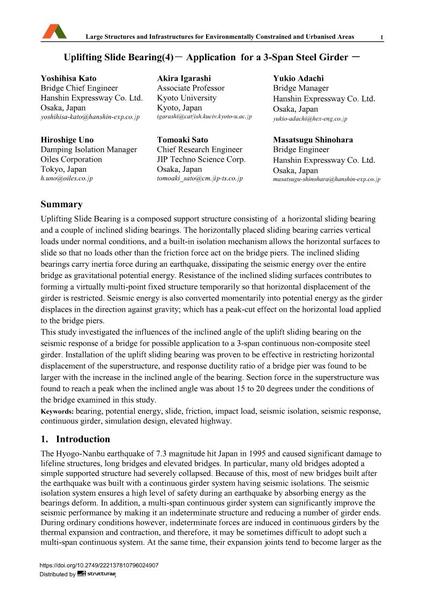Uplifting Slide Bearing (4)- Application for a 3-Span Steel Girder

|
|
|||||||||||
Bibliographic Details
| Author(s): |
Yoshihisa Kato
Akira Igarashi Yukio Adachi Hiroshige Uno Tomoaki Sato Masatsugu Shinohara |
||||
|---|---|---|---|---|---|
| Medium: | conference paper | ||||
| Language(s): | English | ||||
| Conference: | IABSE Symposium: Large Structures and Infrastructures for Environmentally Constrained and Urbanised Areas, Venice, Italy, 22-24 September 2010 | ||||
| Published in: | IABSE Symposium Venice 2010 | ||||
|
|||||
| Page(s): | 358-359 | ||||
| Total no. of pages: | 7 | ||||
| Year: | 2010 | ||||
| DOI: | 10.2749/222137810796024907 | ||||
| Abstract: |
Uplifting Slide Bearing is a composed support structure consisting of a horizontal sliding bearing and a couple of inclined sliding bearings. The horizontally placed sliding bearing carries vertical loads under normal conditions, and a built-in isolation mechanism allows the horizontal surfaces to slide so that no loads other than the friction force act on the bridge piers. The inclined sliding bearings carry inertia force during an earthquake, dissipating the seismic energy over the entire bridge as gravitational potential energy. Resistance of the inclined sliding surfaces contributes to forming a virtually multi-point fixed structure temporarily so that horizontal displacement of the girder is restricted. Seismic energy is also converted momentarily into potential energy as the girder displaces in the direction against gravity; which has a peak-cut effect on the horizontal load applied to the bridge piers. This study investigated the influences of the inclined angle of the uplift sliding bearing on the seismic response of a bridge for possible application to a 3-span continuous non-composite steel girder. Installation of the uplift sliding bearing was proven to be effective in restricting horizontal displacement of the superstructure, and response ductility ratio of a bridge pier was found to be larger with the increase in the inclined angle of the bearing. Section force in the superstructure was found to reach a peak when the inclined angle was about 15 to 20 degrees under the conditions of the bridge examined in this study. |
||||
| Keywords: |
seismic response seismic isolation bearing continuous girder friction impact load slide potential energy simulation design elevated highway
|
||||
